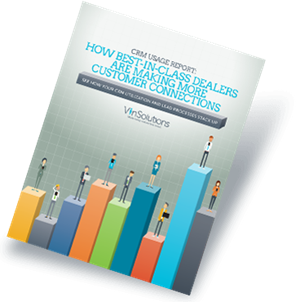Your dealership’s CRM has some obvious benefits for gathering customer information and making the sales process more streamlined. However, it’s not enough to just use the basic features and hope to close more sales and increase customer retention.
VinSolutions partnered with training and consulting firm DealerKnows to look at how the automotive industry is using CRMs. In every category, dealers who followed best practices and dug into the advanced features of their CRM connected with more customers, more effectively.
It takes more than just advanced features to get maximum value from your CRM. You must also create and follow realistic and effective lead processes. Each task within your CRM should drive your team toward improving connections with customers and selling more cars. Make sure your processes are optimized so that the tasks are achievable for your sales team, but sophisticated enough to improve performance and improve customer connections.
Here are three key areas to investigate at your dealership to determine if your CRM is working as hard as it could be:
1. Lead Response Time
How long does it take you to follow up with a customer after they contact your dealership? Experts agree that it should be within less than an hour – really within 5-20 minutes. Only 73.9% of the best-in-class dealerships were following up on leads within an hour in the most recent survey. This is an improvement over previous surveys, but still represents missed connection opportunities.
A CRM like Connect CRM can help you follow up with leads faster by:
Facilitating faster internal communications
Assigning a team member for each lead
Prompting multiple call-backs in the crucial first day and week of the sales cycle
Setting up contact alerts and reminders for various points throughout the customer lifecycle
2. Data and Reporting
Reports based on data from your CRM can be invaluable for showing you what your dealership is doing right and where your team could stand to improve its processes. A policy of “if it’s not in the CRM, it didn’t happen” is key, because you can only report on data that is in the CRM.
With clean, comprehensive CRM data, you can run useful reports on open opportunities and sales associate activity to get a clear picture of how your dealership is performing. Here are some other tips to make reporting more effective:
Set up regular automated reports to save time and ensure that you are always monitoring customer interactions. Automatic daily reports will help you identify patterns and anticipate necessary process improvements.
Sales management should help choose the metrics that mean the most for the dealership and set the standard for entering the associated data.
Your process should include routinely removing duplicate leads to ensure accurate reporting.
3. Customer Engagement
Your initial goal may be to sell one vehicle, but your ultimate goal is always to build a long-term connection with customers. You want them to view your dealership in a positive light and consider it a helpful resource. Here are some ways your CRM can help you nurture and solidify your relationship with customers:
Track your customers’ preferred methods of contact. Find out how and when your customers wish to interact with you and gear your communications toward those preferences.
Personalize your communications based on what you know of your customers’ interests.
Set up alerts to track responses from customers and respond quickly to messages you receive.
Your CRM is packed with powerful features that can have a significant impact on sales and customer retention. Just make sure you fine-tune your processes and focus your team on efficiently completing all tasks.
Interested in learning more?
Download the White Paper

.jpeg?w=600)
